Past and future satellite service
Cosmos was and remains an aggressive environment for us, in which a person can live from the strength of one and a half minutes, having spent in consciousness only a few seconds of them. However, we completely compensate our physiological deficiencies with the engineering genius of spacecraft designers and spacesuits. Start of STS-135 mission July 8, 2011 - last shuttle mission
One of these manifestations was the Space Shuttle program - along which 6 ships were built (one of which, instead of lost in an accident), which were able to transport 355 astronauts during their 135 flights of the total number of people flying in space at the moment in 551

people), spending a total of 1322 days in orbit and also becoming the most expensive program in NASA history with a price of $ 210 billion for 2010 (more expensive than $ 150 billion spent on the ISS at that time, and $ 193 billion spent on the program Apollo "in 2010 prices).
But the Space Shuttle program is remarkable not only for its wild value and the fact that it transported 2/3 of all people in space: during this program 8 repairs were made in open space (5 of which were from the Hubble telescope ) and 5 satellites orbiting in 4 missions.
STS-41C mission (April 6-13, 1984)
It was only the 11th flight of the Space Shuttle program and its golden era was just beginning (which will soon end with the Challenger disaster ). In this flight, there was almost everything that fiction writers expected from the flight of the space shuttle: launching a new satellite into orbit and repairing the old one, catching a satellite with a manipulator and flying an astronaut in a spacesuit without a tether to the ship. The shuttle was launched into an orbit at a height of 533 km, and then the next day after launch, the crew of the Challenger unloaded with the Canadarm manipulator an installation for long-term exposure of samples in space ( LDEF
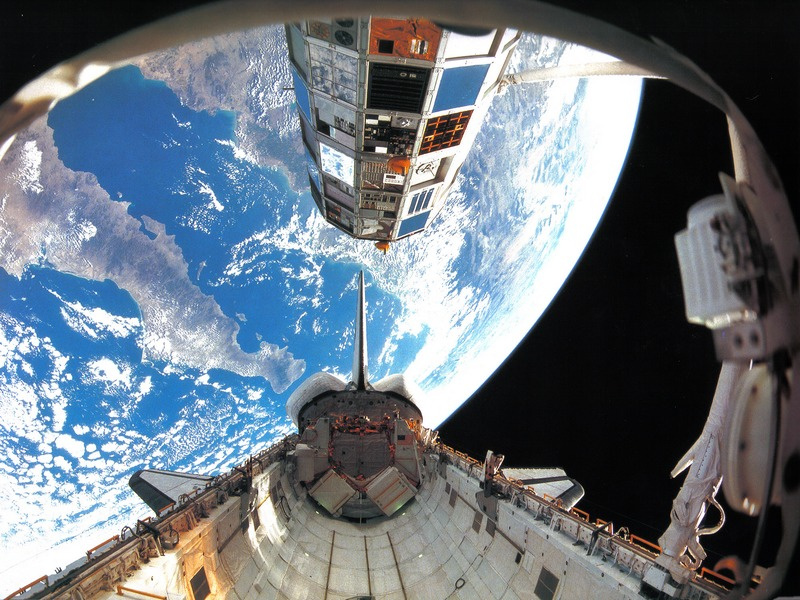
) - it is a 12-cylinder body in the form of a cylinder weighing 9.7 tons, on which 57 samples of materials provided by 200 scientists from 8 countries were located.
The next day, the crew raised the orbit to 560 km to meet with the failed SMM satellite (Mission Solar Maximum). As early as November 1980, SMM failed one of the fuses in the orientation system, as a result of which only an electromagnetic orientation system remained in operation, which “rested” on the Earth’s magnetic field. But this system had insufficient pointing accuracy, as a result of which only 3 of the 7 satellite instruments could follow the sun.
The first satellite to repair was to be placed in the cargo hold of the shuttle, but to James van Hoften and George Nelsonin three attempts, it was not possible to do this with the help of a special gripping tool (because of a sleeve that was not on the drawings of the apparatus). As a result, the astronaut had to improvise, and Nelson, clutching his solar panels, began to slow down the satellite using the engines of his manned maneuvering module ( MMU ). Since the force was applied far not to the axis of rotation of the apparatus, the rotation did not slow down at all, but became uncontrollable along several axes at once. SMM Management Center
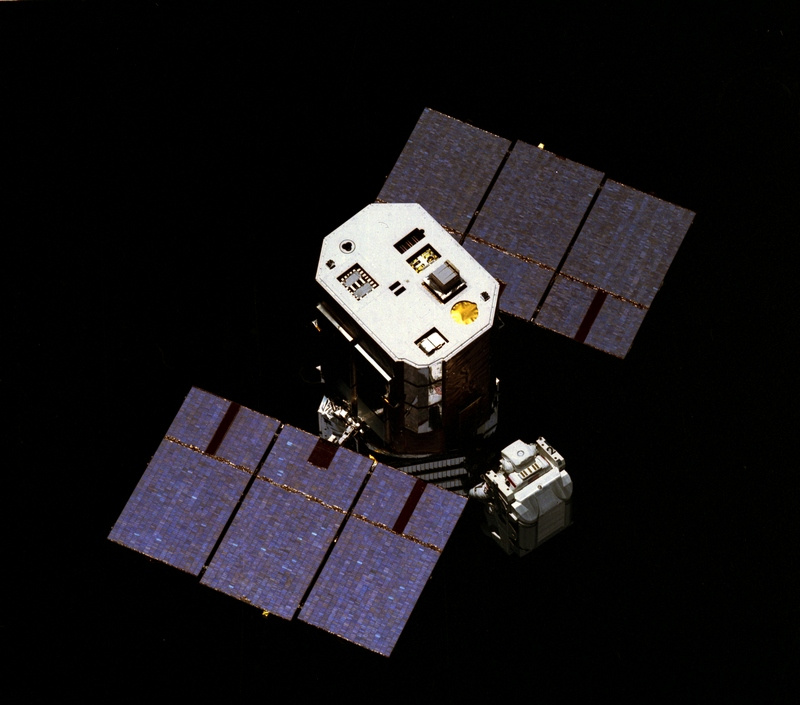
I had to urgently turn off all non-critical devices (since the orientation to the Sun was completely lost and the device began to quickly lose battery power), but eventually it was possible to extinguish the rotation using the electromagnetic orientation system, after which it was captured by Canadarm and immersed in the cargo compartment. After that, the SMM replaced the orientation system, the electronic control unit of the coronagraph, and installed a gas casing over the X-ray polychromatograph. In the end, after two astronaut exits into space, the device was restored, and after a month of tests it was put back into operation.

The main and alternative mission stripes: the main one above the astronaut who catches SolarMax is the schematic sun that he studied; on the alternative patch there is a black cat with burning eyes, under which the shuttle flies - symbolizing the landing of the mission on Friday the 13th, which, among other things, also originally had the designation STS-13.
STS-51A mission (November 8-16, 1984)
This was already a mission for a full-fledged space shuttle: two Canadian satellites Anik D2 and Syncom IV-1 had to be put into orbit, and also two satellites, Palapa B2 and Westar 6, which were removed by the STS-41B mission, were removed from orbit, but due to engine malfunctions could not reach the calculated orbit. Even before the launch of Discovery, the satellites were transferred from orbit to 970 km per 340 km (since the shuttle could not reach such a high orbit). Satellite Anik D2 was launched on the second day of the mission, and Syncom IV-1 - on the third.
This was followed by two days of orbital maneuvers, which eventually brought the shuttle to a meeting with the satellite Palapa B2. Joseph Allen flew over with the help of the MMU to him and put in a tool called “Main Engine Capture Device” or simply “Sting”to the satellite propulsion nozzle (since this engine is located on the line of the center of mass of the satellite, this was the most convenient place to capture).

Using the tool, he managed to reduce the satellite’s rotational speed to 1 rpm, but the first attempt by Dale Gardner (docked at the end of the Canadarm manipulator ) to capture the satellite was not successful. However, the second time, with the support of Anna Fisher (who managed Canadarm), they nevertheless succeeded. The whole operation took about 2 hours.
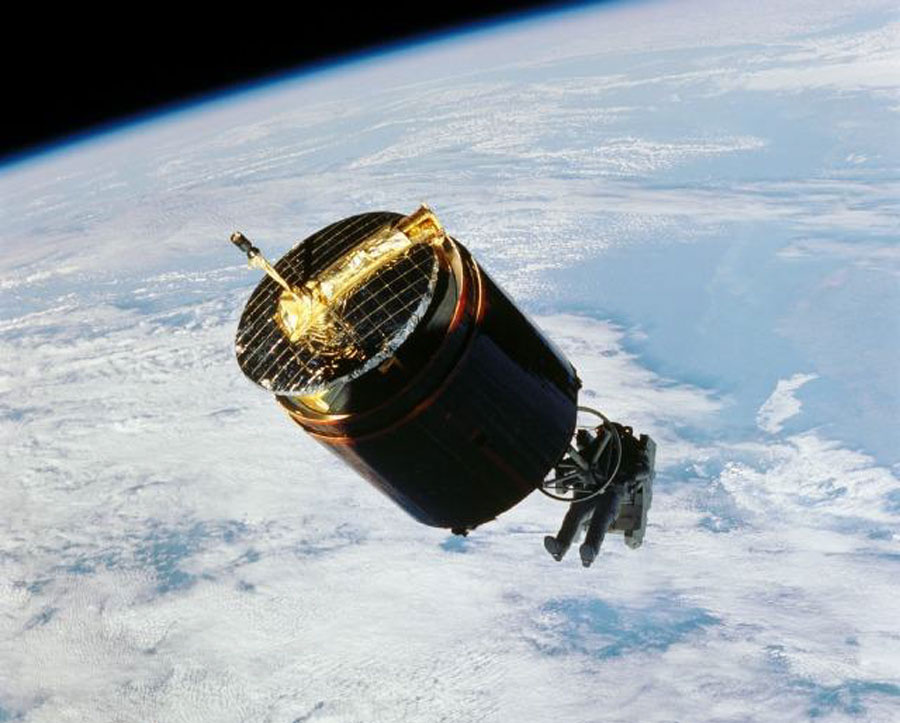
The next day, they were expected by the second satellite (Westar 6), which was easily captured by the same instrument by Dale Gardner, and transferred with the support of Joseph Allen.in the cargo compartment "Discovery". Gardner was jokingly photographed with a sign “For sale” (referring to the status of these satellites). Westar 6 was eventually sold to AsiaSat , and flew as satellite No. 1 of this company after 6 years (April 7, 1990). Frames of these two missions (STS-41C and STS-51A), along with shots of a number of other shuttle flights, ended up in the movie “The Dream Is Alive” , the name of which turned out to be prophetic - the number of flights of the shuttles grew not by years but by months, and the dream of a cheap space shuttle really stayed alive until the next event. The Challenger crash on January 28, 1986 It is believed that the second crash led to the closure of the Space Shuttle program ( the Columbia shuttle
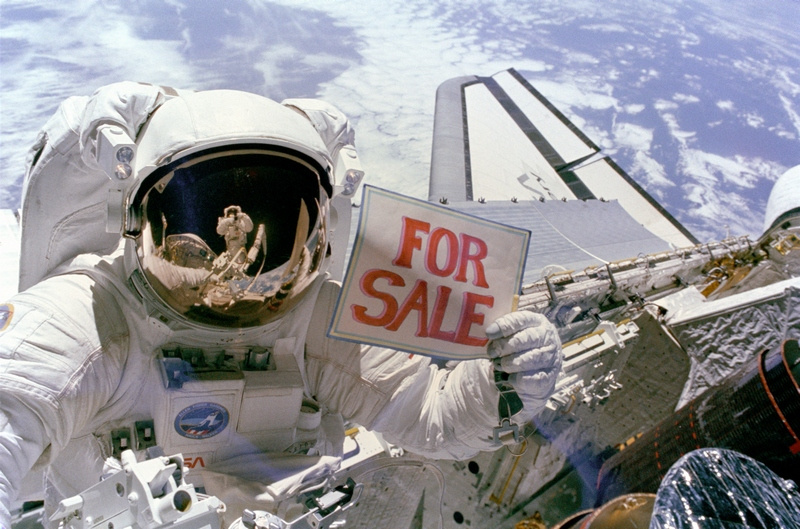
). However, in my opinion, the program had no chance after the first one. The Ministry of Defense, which was going to use the shuttles for its own purposes, set wild requirements for them with a payload capacity of 30 tons, due to which the program had practically no chance of reaching the calculated level of 50 flights per year (which should have provided the system with a cost of about 1.5 Thousands of $ per kg).
Moreover, the military had already built the SLC-6 platform on the basis of Vandenberg to launch the shuttles with their cargoes (the first flight from it was to take place already on October 15 in the same year) washed their hands and abandoned the shuttles in favor of the Titan IV rocket. Thus, the shuttles lost many orders, and the polar orbit was forever closed to them. NASA recognized the MMU too dangerous and never used again. Both MMUs that flew into space were kept in a clean NASA room until 1998, after which they were sent to the National Museum of Aeronautics and Aeronautics and the Rocket and Space Center in Huntsville .
STS-32 mission (January 9-20, 1990)
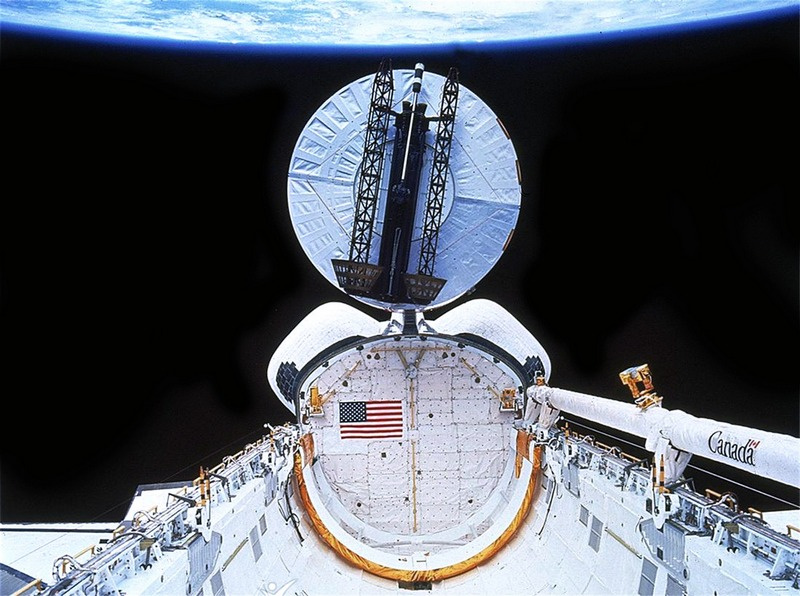
After the withdrawal of the 12-ton Syncom IV-F5 satellite on the second day of the mission , the crew proceeded to return the installation with the samples for displaying the LDEFwhich, due to many delays, hung in orbit for 4.5 years longer than the planned 11 months, and was already close to burning in the atmosphere, dropping too low. The crew took about 4.5 hours to take samples on the surface of the LDEF, then picked it up with Canadarm and loaded it into the cargo hold. For the sake of medical research for a long stay in space, the crew stayed in orbit, setting a new record for 11 days of the space shuttle’s stay. STS-49 mission (May 7-16, 1992) The mission of this mission was the repair of the Intelsat 603 satellite which could not reach the geo-transition orbit due to the fact that the third stage of the Titan CT-3 launch vehicle
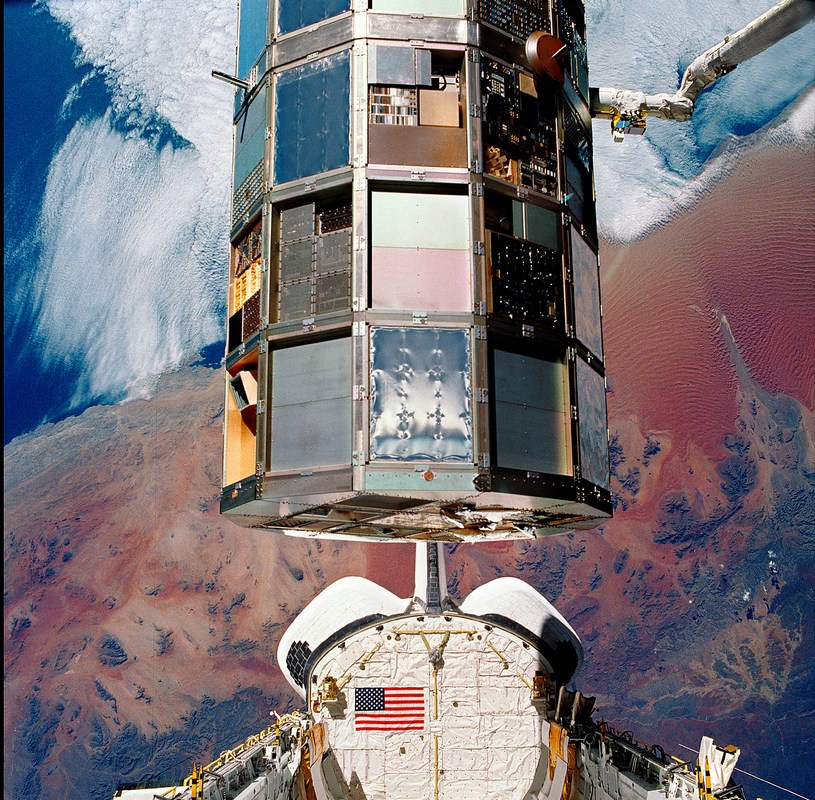
not separated from the upper stage. The crew needed to attach the satellite to the new upper stage, but first of all it was necessary to dock with the satellite. Pierre Tuot and Richard Hib went twice into space (for 3.7 and 5.5 hours) trying to attach the satellite to the rod, but they did not succeed. As a result, they had to improvise: Thomas Akers joined the two astronauts who had left before , and the three of them still managed to catch a 4.2-ton satellite (albeit spending another 8.5 hours). In spite of such delays, Tuot and Akers conducted another (already the fourth) 7.7-hour spacewalk in order to conduct tests confirming the possibility of assembling the Freedom station in orbit .
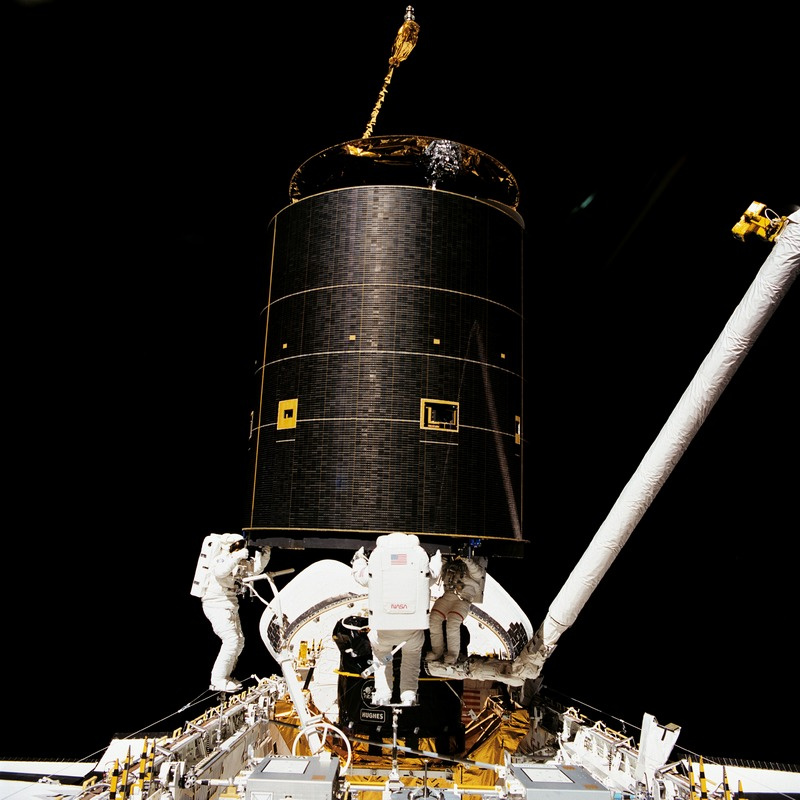
(although this output still had to be reduced, but the station did not fly as a result, but was eventually transformed into the ISS ). As a result, the astronauts for this mission spent in the open space 25 hours and 27 minutes.
STS-57 mission (June 21 - July 1, 1993)
In this mission, the crew needed to return the European returnable carrier ( EURECA ) on which the samples were placed for exposure in conditions of weightlessness and vacuum. On the shuttle "Endeavor" was installed the wrong side of the connector through which the satellite was supposed to be powered, due to which the satellite double antenna had to be folded manually during an almost 6-hour spacewalk. However, everything else went as it should and the astronauts spent the rest of the mission doing experiments inSpaceheb . STS-61 mission (December 2-13, 1993) Almost immediately after the Hubble telescope was put into orbit by the Discovery shuttle on April 24, 1990, it became clear that the telescope’s main mirror had a defect: the edges of the mirror were made with a smaller bend than it is supposed, and although the deviation was only 2.2 microns - the spherical aberration produced by him very seriously spoiled the pictures: Pictures of the M100 galaxy before and after installing the correction system The main mirror weighed 828 kg with a diameter of 2.4 meters and it was almost impossible to make and replace . Therefore, it was decided to install on the Hubble optical correction system ( COSTAR
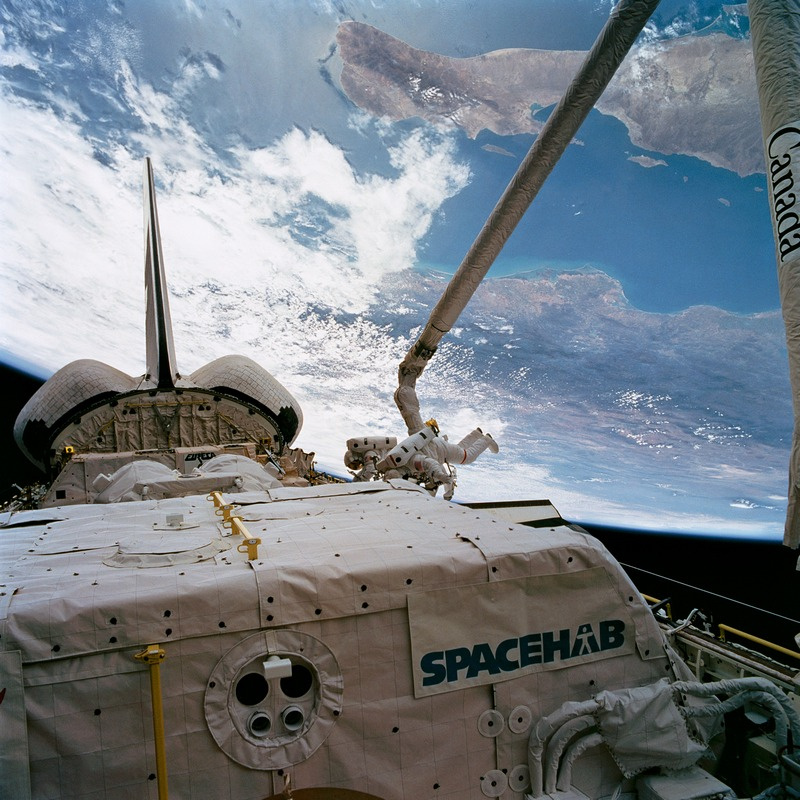
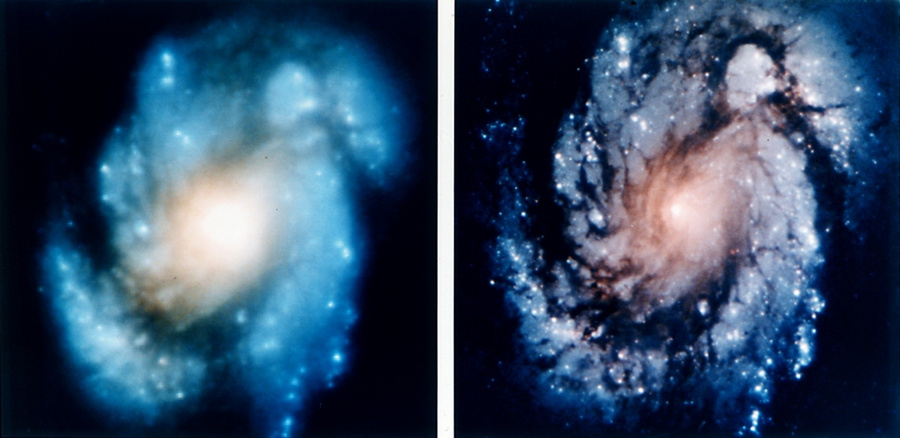
) which would compensate for the aberration. Because of the hurricane that reached Cape Canaveral on October 30, the hangar where the shuttle was going was contaminated, and the assembly of Endeavor had to be moved from the hangar of the launch pad 39A to position 39B. November 18 in the shuttle was detected malfunction of one of four amplifier probes elevons , but because access to it was only possible through the rear landing gear (which required installation of the shuttle back to the assembly plant and disassembly of the structure), and the commission allows operation 3 of 4 amps - the sensor was disabled and was not used in flight. The first attempt to start on December 1 was canceled due to weather conditions, so the shuttle started from the launch pad 39B on December 2.
In preparation for the upcoming repair, the entire second day of the flight was allocated to the crew for rest. On the third day of the flight, the Hubble Operations Control Center handed a command to the telescope to fold its two directional antennas, and the crew made several orbital maneuvers to come close to the telescope. After a visual inspection, the Hubble was captured by the shuttle's manipulator, and the crew returned to rest.
In this mission, the shuttle crew set a record for the duration of a spacewalk among all the missions of shuttles at that time (35 hours and 28 minutes for 11 days of flight) and not to exhaust two astronauts to the end (which threatened to lose their attention and the telescope or even serious risks for the crew itself) during spacewalks, the composition was rotated: 1, 3 and 5 output was carried outFranklin Musgrave and Jeff Hoffman , while 2 and 4 are Thomas Akers and Catherine Thornton (who also participated in the STS-49 mission, the second in duration ). Hubble with new roll-type solar batteries (two red cylinders on the sides), old batteries with the logo of the European Agency ESA - stacked in the foreground
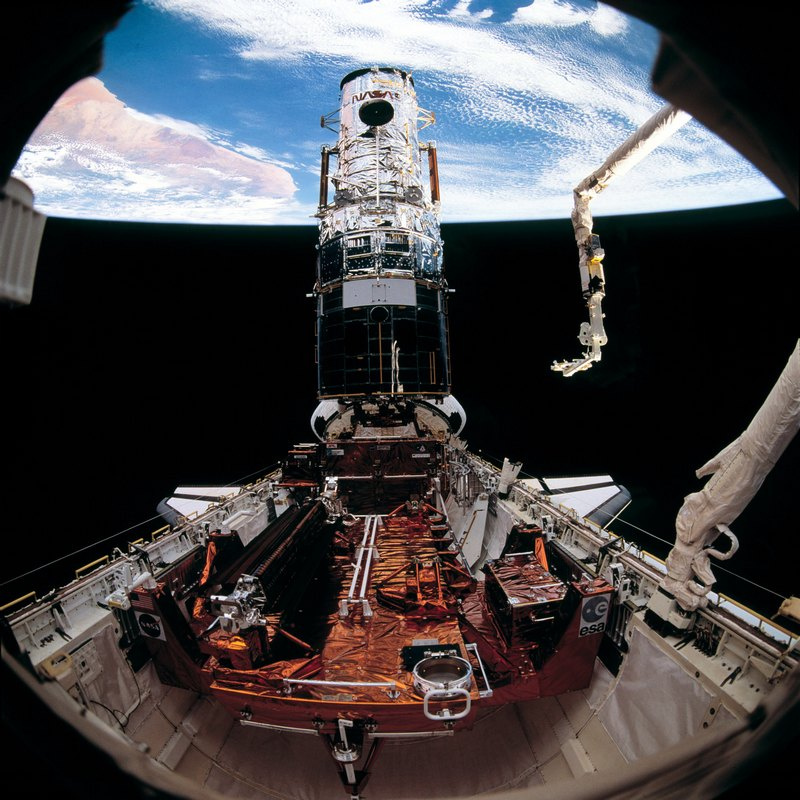
On the fourth day, the first spacewalk was planned, taking almost 8 hours (the second longest spacewalk for NASA astronauts at that time). Since the MMU crews of space shuttles did not exist anymore - a mechanical link with a shuttle or a telescope in the process of work became vital for astronauts. Therefore, immediately after leaving the airlock, Jeffrey Hoffman installed a platform for attaching legs to the shuttle's manipulator. Franklin Masgrave stood on it and installed protective covers on the omnidirectional antenna and its bearing (under voltage), opened the door of the telescope equipment compartment and installed the second leg mount inside it.
Then the repair began directly: two pairs of gyroscopes and two gyro control units were replaced, after which 8 Hubble electrical fuses were replaced, after which its gyroscopes completely restored their performance. To close 2 of 4 locks on the doors of the section with gyroscopes, the efforts of both astronauts had to be made (the engineers suggested that this was due to the temperature difference that occurred while the doors were open).
The next day, during the 6.6-hour exit, the solar panels were replaced. In this case, Thornton at the beginning had problems with pressure in a spacesuit, and after that - problems with communication, so that all the information to Thornton MCCtransmitted through Akers. The damaged wing of the solar panels was removed from the telescope during the night passage over the Sahara (to reduce the negative effect of its absence), after which a new one was installed. The faulty wing was dropped on the day side over Somalia, after which the shuttle made a small maneuver at 1.5 m / s to move away from it. The second wing was loaded into the cargo hold and returned to the European Agency ESA for analysis.
During the third 6.8-hour exit, the next day, a planetary and wide-angle camera was installed, and both telescope magnetometers, which served as a compass for the coarse orientation of the Hubble, were replaced. The planetary camera had improved characteristics in the ultraviolet spectrum, as well as its own aberration correction system (from this point on all the cameras of the telescope were supplied with a similar system). The fourth output, which lasted 6.8 hours, was replaced by a high-speed photometer and the COSTAR optical correction system was installed , which allowed the telescope to achieve those amazing resolution characteristics that should have been obtained initially. After the exit is completed, pilot Kenneth Bowersoxperformed the orbital maneuver that raised the orbit of the Endeavor and Hubble ligaments from 587 km to 594 km to an altitude of 594.3 km to 595.8 km ( perigee / apogee ). The output of 7.4 hours, performed on December 8, was replaced by the solar control electronics, after which the crew transferred commands to their disclosure, but there was no effect. After that, a command was issued to uncover one wing of the solar panels using both engines, but this too was not a success. The solar panels began to unfold only after the astronauts manually folded the disclosure mechanism, and again gave the command to open the batteries. After that, the Goddard high resolution spectroscope was connected back.
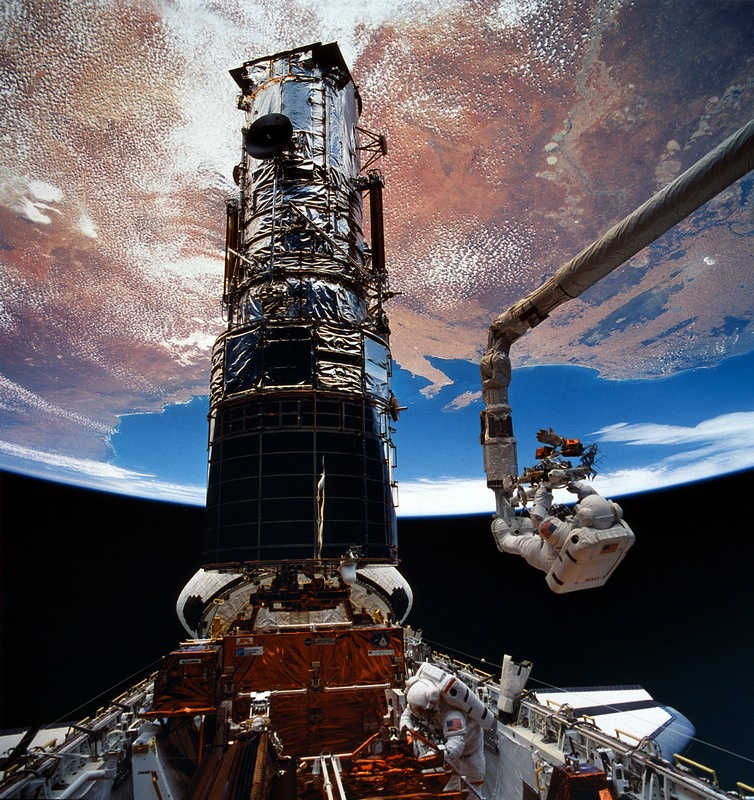
and installed covers for magnetometers, made right on board the Endeavor. After that, the spacewalk was completed, and the Hubble straightened its directional antennas, after which it was released into free flight.
STS-72 mission (January 11-20, 1996)
This mission was to return the Japanese satellite Space Flyer unit who studied microgravity and carried samples for display in space. Shuttle manipulator in this mission was controlled by Koichi Wakata - 4 astronaut of the Japanese space agency JAXAfor which it was the first of his 4 flights. On command from the Earth, the satellite’s solar batteries were folded, but the sensors indicated incomplete packing of them into containers, which was why they had to be shot off together with the containers. However, this only delayed the meeting of the Endeavor shuttle with the satellite for 1.5 hours, and the seizure of the satellite by the manipulator and its loading into the cargo hold were completed normally. On the 4th day of the mission, the OAST-Flyer was unloaded from the cargo compartment, which carried several experiments: comparing the real impact of spacecraft pollution with a computer model, a GPS technology demonstrator and an amateur radio experiment from the University of Maryland
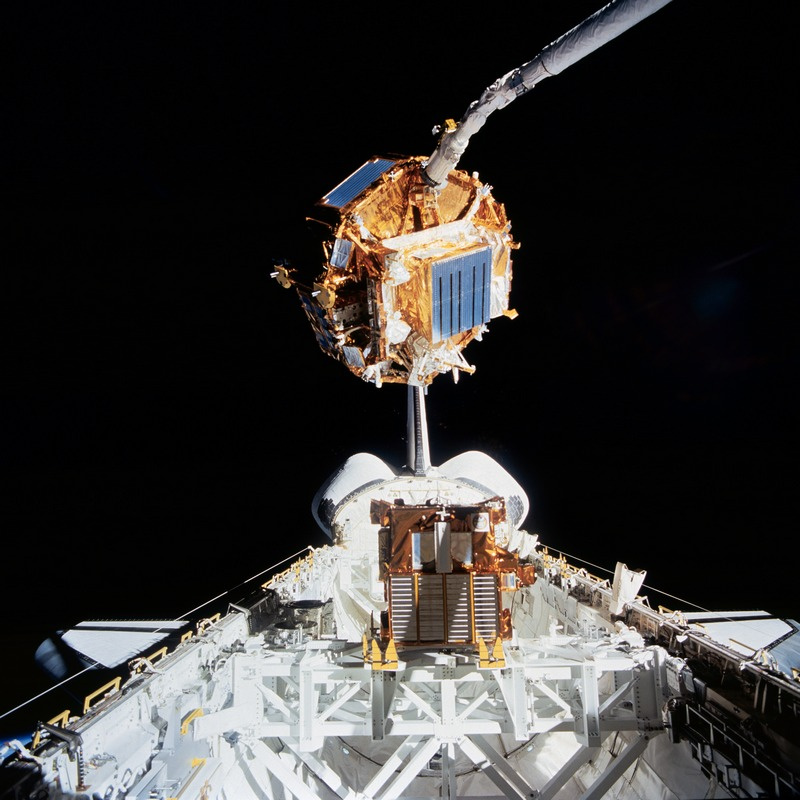
. The device in free flight moved away from the shuttle by 72 km, but after 50 hours, according to the plan, it was returned by the manipulator back to the cargo hold. Also during the mission, two space missions were made at about 6 and 7 o'clock each, for testing the technologies necessary for the construction of the ISS.
STS-82 mission (February 11-21, 1997)
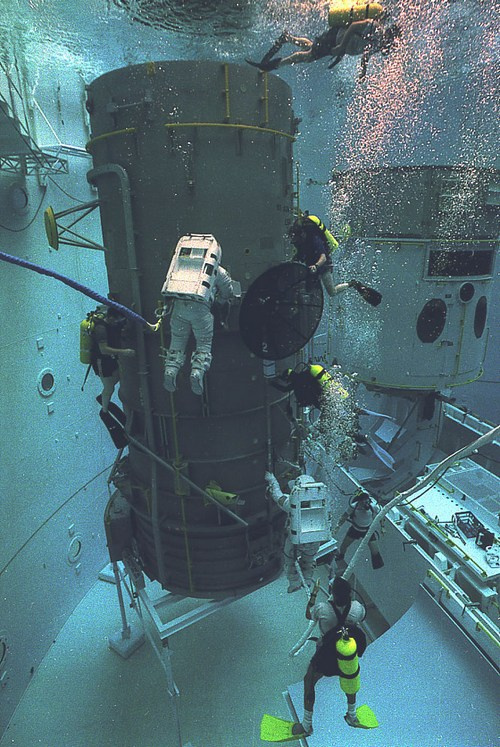
Astronaut training on a Hubble telescope in a neutral buoyancy simulator
This was Hubble’s second maintenance mission, which was supposed to be much simpler and only require 4 spacewalks. On the third day of the mission, the Discovery shuttle was docked and the first 6.7-hour spacewalk, during which Goddart High-Resolution Spectrograph and Dim Objects were dismantled, the Space Telescope Recording Spectrograph and Near-Infrared Camera were installed in their place and multi-object spectroscope ( NICMOS ).
The next day, the second 7.5-hour output was carried out, in which the Precise guidance sensor was replaced (along with the installation of a new unit to increase its accuracy) and a tape recorder for engineering scientific recordings, and the insulation was worn on the side facing the Sun and directed in the direction of the telescope. In the third 7.2-hour output, the data interface unit and engineering and scientific reel-to-reel tape recorder for engineering and scientific records (with a solid-state drive) was replaced a day later.
After this spacewalk, it was decided to add another plan to the plan to repair the insulation. On day 6 of the mission, the last, according to plan 4, spacewalk of 6.5 hours duration was carried out, in which the electronic control unit of the solar batteries was replaced and the thermal blanket around the telescope magnetometer was replaced with multilayer insulation. On the same day, two other astronauts were preparing a replacement for the isolation of the Hubble, which they installed the next day, entering an unscheduled spacewalk. In addition, during the mission, the telescope's orbit was raised by almost 15 km, thereby becoming a record flight altitude of 620 km for both the shuttle and the Hubble. The total time spent by astronauts in outer space was 33 hours and 11 minutes.
For the rest of the crew, the same way as last time, astronauts going out into space were rotated: Mark Li and Stephen Smith carried out 1, 3 and 5 spacewalks , while Gregory Harbo and Joseph Richard performed 2 and 4 .
STS-103 mission (December 20-28, 1999) This mission was originally planned for June 2000, but due to the failure of 3 of 6 Hubble gyroscopes successively in 1997-1999, it turned out to be one failure to make it impossible to continue his mission (without 3 working gyroscopes, accurate telescope aiming at the target was impossible). It would be a real disaster for astronomers, because the telescope time is literally signing years ahead, and only
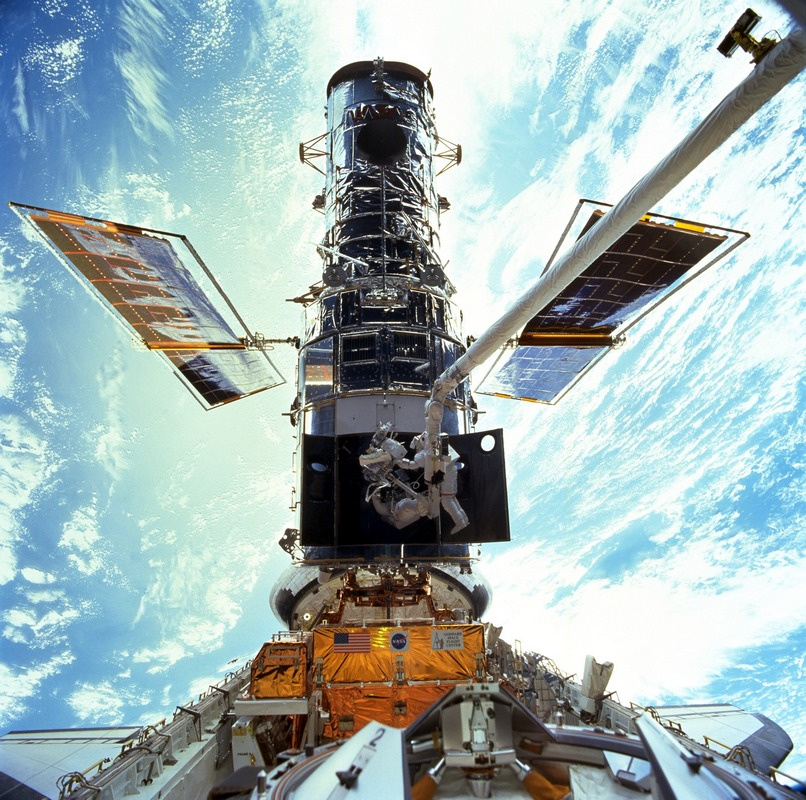
1/5 of the proposals for observations is accepted - it even led to the development of the Space Planning and Scheduling System Science Observation Science Program ( SPSS ) by the Space Telescope Research Institute .
Telescope gyroscopes are wheels rotating at a frequency of 19,200 rpm, whose electric motors feed on conductors as thick as human hair. The reason for the failure was the oxidation of conductors with oxygen, so that all 6 new gyroscopes were filled with nitrogen and placed in pairs in the speed sensor assemblies. In addition to new gyroscopes, the crew once again replaced the Precise guidance sensor and the on-board computer, which, being 20 times faster and having 6 times more memory, made it possible to shift part of the internal checks of the apparatus from the Earth to internal funds, thereby reducing operating costs.
An improved set of battery voltage and temperature controls was also installed, which was supposed to prevent them from failing when the telescope went into protection mode, and one of the two S-band transmitters intended to communicate with the Earth via NASA’s TDRS network was replaced (in exchange for out of service in 1998). In addition to all this, 2 out of 3 Hubble reel-to-reel tape recorders was replaced with a solid-state drive. Also, this flight turned out to be remarkable in that one of the twin astronauts Scott Kelly , who has the thirdfigure for the total duration of flights among NASA astronauts (520 days), but at that moment it was for him only the first flight. In total, the crew spent 3 spacewalks a little longer than 8 hours each.
STS-109 mission (March 1-12, 2002) Hubble telescope and Columbia shuttle performing its penultimate mission
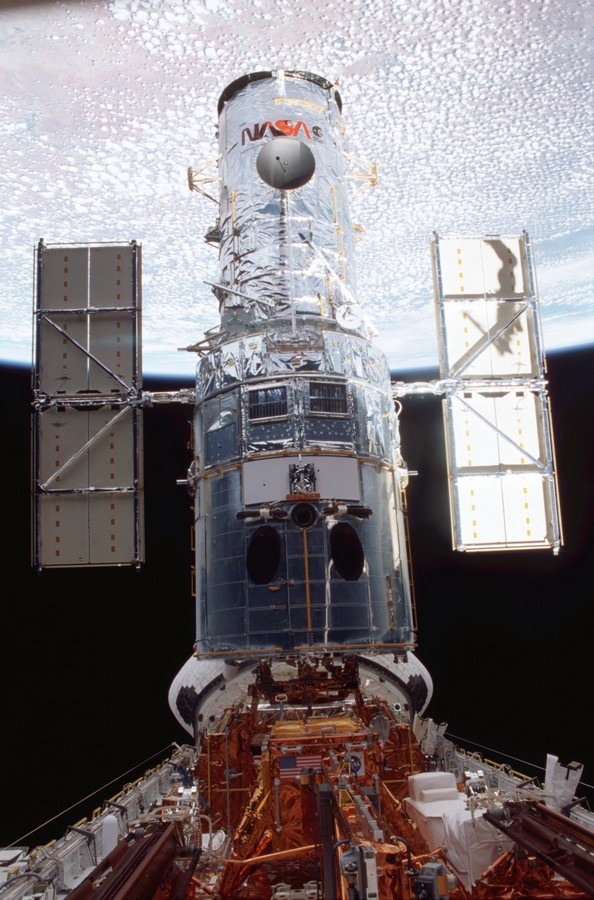
Since the gyro failures required a forced shift of the previous mission to the left, this mission had to complete what was planned to be completed during the third service mission: to install an Advanced Surveillance Camera, new solid solar batteries, a power management unit, to install an experimental cryogenic cooler for the Near Infrared Camera and multi-object spectrometer. In total, it took 5 days and 5 spacewalks lasting 35 hours and 55 minutes. As in the past times, the composition of the astronauts changed: at the beginning, John Gransfeld and Richard Linnehan went out into space , then they were replaced by James Newman and Michael Massimino , after which everything repeated again.
STS-125 mission (May 11-24, 2009)
The crash of the shuttle Columbia that occurred during its return from orbit on February 1, 2003, finally crippled the project. All missions except the critical ones (which included the assembly of the ISS and one Hubble maintenance mission) were canceled, and after each launch of the shuttle, using the camera on its manipulator, it was completely checked for the presence of damaged tiles. In case of the need to evacuate the crew from the "wrecked" shuttle, at almost every launch, the second of them was on duty, who, after checking the surface, was sent back to prepare for their flight. Flying for the first time to a meeting with Hubble Atlantis and Endeavor insuring it (from behind). This was the final mission.
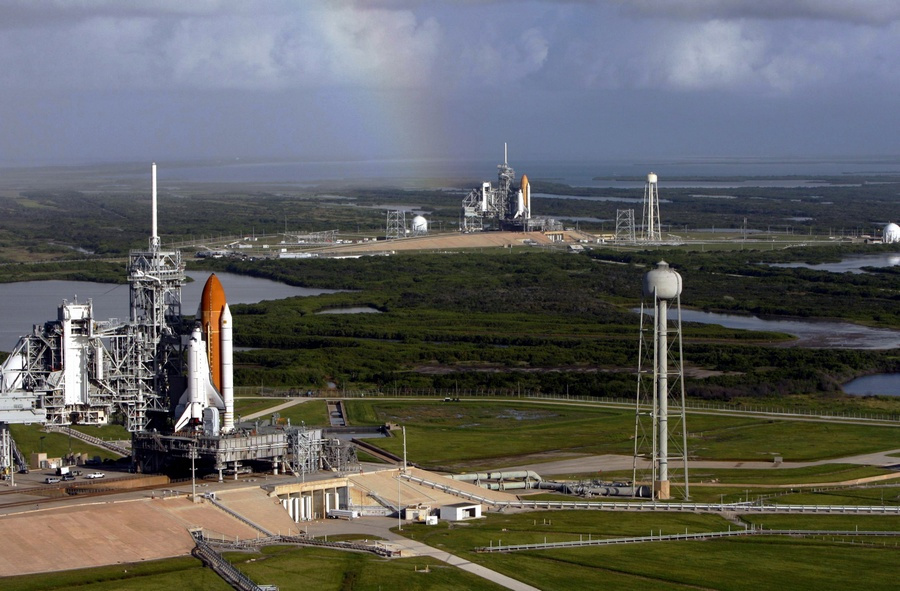
repair of Hubble and others was no longer planned, so the crew had to do everything more thoroughly and clearly than usual, as they had no other chance to return and fix something. On the third day of the flight, the crew made docking with the Hubble and carried out a visual inspection of the telescope. The first 7.3-hour spacewalk was replaced by a wide-angle camera and a partially malfunctioning computer processing and transmission of data, and a soft capture mechanism compatible with the NASA docking system was installed, which was intended to further control the telescope from the orbit will even be used for another mission of his service).
In the course of the second, almost 8-hour output, carried out the next day, all 6 Hubble gyros and 3 rechargeable batteries were replaced. In the course of the next 6.6-hour exit, the optical correction system was dismantled which once saved the Hubble (and is no longer needed because all the instruments of the telescope were equipped with their own correction systems; now this system is being exhibited at the National Aviation Museum and space in Washington). A cosmic-radiation spectrograph was installed in place of this system and repairs were made to an improved observation camera, in which a short circuit occurred in 2007, which disrupted several electronic components.
The next day, during the 8-hour exit, the power supply of the recording spectrograph was repaired. Because of a jammed thread on one of the 4 screws, the handle on the body of this device had to be pulled out by force, fortunately the remaining 107 screwsturned out to be in order, but it still took too long, and the second task had to be moved to the final output. Instead of the old power supply cover with 100 screws, a new one was installed - with two latches: it remains only to guess what the designers thought about when inventing such an intricate fastening. A day later, the fifth in a row 7-hour spacewalk was carried out, during which the second pack of 3 telescope batteries was replaced, and 3 heat-insulating panels were installed (one of which was not installed last time). At the end of the exit, the astronauts removed the protective covers from the antennas and issued a command to open them.
The next day (May 19, 2009) the telescope was undocked from the mountings in the cargo hold, and using the shuttle's manipulator at 12 57 hours UTC set off on your free flight.
The moment of separation of the Hubble from the shuttle Atlantis
After several months of testing, the Hubble telescope resumed its shooting in early September 2009, with which it is still engaged. Thus, during this mission, astronauts spent 36 hours and 36 minutes in open space, and for all 5 missions servicing the Hubble telescope - 20 astronauts serving the telescope totaled a total of 13 days 12 hours and 6 minutes in open space.
USSR and Russia
Our cosmonauts did not have the opportunity to fly the Buran and repair any satellites. However, the periodic opportunity / need to do the repair was presented to them: in addition to the Soyuz T-13 rescue operation(about which you can read in the book “Notes from the dead station” from one of its two participants, VP Savinykh) and the collision of the Progress M-34 cargo ship with the MIR station (during which the solar batteries and the station's radiators, as well as the hermetic housing of the “Spectrum” module , which, despite repeated attempts to repair it, flew 2 years before the station was flooded in an unsealed state , was punched .
There was also a remarkable case with the recently deceased Georgi Grechko.who was fascinated with the repair of the OST-1 solar telescope at Salyut-4 station: the PMU believed that the telescope could not be repaired and did not allocate time for astronauts to repair it, so he snatched this time from sleep (for which he was reprimanded), but in the end he managed to fix it, for which later Nikolay Chernykh called him one of the asteroids discovered by him (number 3148 ). In addition, there were a lot of current equipment repairs at the stations of the Salyut series , all of which are simply impossible to list.
Present and Future
Since the ISS was completed - almost all spacecraft maintenance has been reducedto the current repair of the station and the launch of the cubsat (which also sometimes can be repaired):
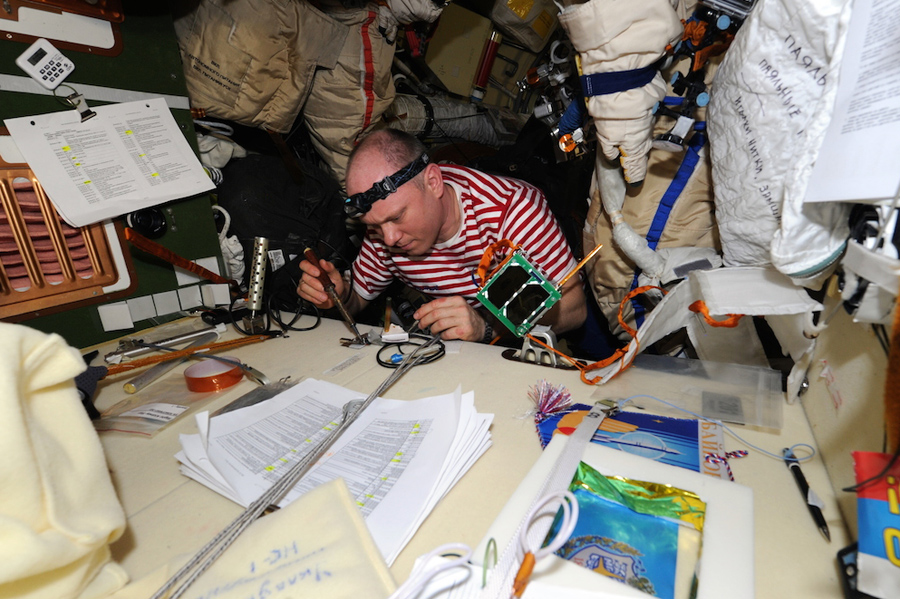
Thus, there was a lull in the manned satellite servicing missions, but it should not last long: despite the loss of Sierra Nevada Corporation in the CCP program (for the delivery of astronauts to the ISS ) they still have an order for 6 flights under the CRS program (for cargo delivery). And their “Running for a Dream” space plan does not intend to surrender: it has already passed the tests with discharge at height and the tests of the braking system. The possibility of using their spaceplane for a maintenance mission is being considered. Hubble telescope in the 2020s.
There are certain advances in automated systems. Since March 9, 2007, two satellites were launched into space : NEXTSat, which performed the role of a target, and ASTRO, which did the docking with it on June 29. During the test flight was docked, the transfer of fuel (hydrazine) and batteries.
At the moment there are two projects of commercial servicing of satellites - SIS and MEV , which are very different: Space Infrastructure Servicing developed by Canadian firm MacDonaldprovides for a ring grip around the main engine of the satellite and the subsequent refueling of the satellite; The Mission Extension Vehicle from the American ViviSat provides for the installation of a gripper inside the nozzle (similar to the “Sting” used on the space shuttle) and does not provide for refueling the target satellite — after docking, the service satellite will use its own orientation system and its engines to maintain the satellite bundle position.
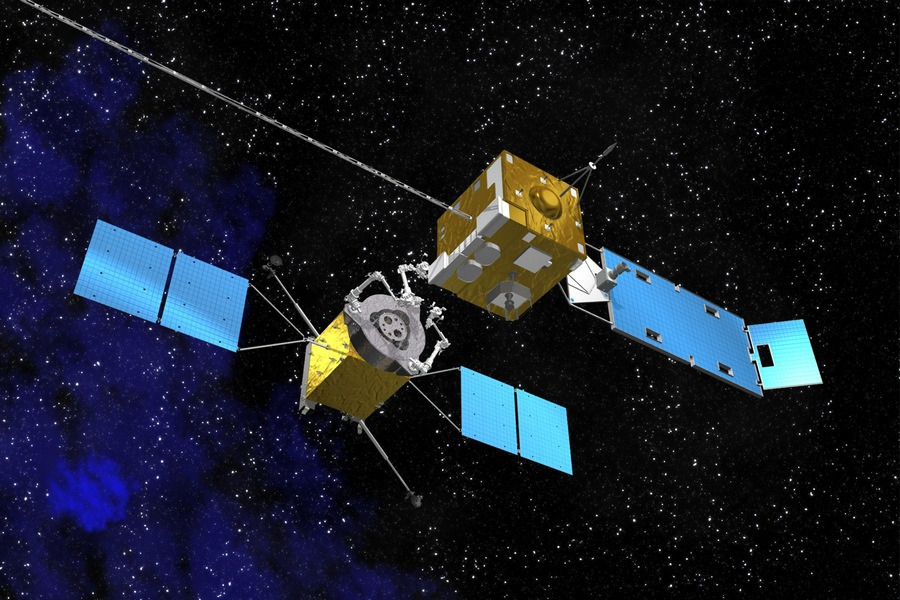
Unfortunately, both projects did not receive the necessary funding at the moment and no test in orbit was made for them. NASA also put forward their proposals in this direction (their Restore-L should fly in the mid-2020s) and ESA(pictured above). Also, the successful launch of June 25, 2016 and the testing of its project from two satellites (target and satellite tanker) was announced by China, but nothing more is known about their project.

people), spending a total of 1322 days in orbit and also becoming the most expensive program in NASA history with a price of $ 210 billion for 2010 (more expensive than $ 150 billion spent on the ISS at that time, and $ 193 billion spent on the program Apollo "in 2010 prices).
But the Space Shuttle program is remarkable not only for its wild value and the fact that it transported 2/3 of all people in space: during this program 8 repairs were made in open space (5 of which were from the Hubble telescope ) and 5 satellites orbiting in 4 missions.
STS-41C mission (April 6-13, 1984)
It was only the 11th flight of the Space Shuttle program and its golden era was just beginning (which will soon end with the Challenger disaster ). In this flight, there was almost everything that fiction writers expected from the flight of the space shuttle: launching a new satellite into orbit and repairing the old one, catching a satellite with a manipulator and flying an astronaut in a spacesuit without a tether to the ship. The shuttle was launched into an orbit at a height of 533 km, and then the next day after launch, the crew of the Challenger unloaded with the Canadarm manipulator an installation for long-term exposure of samples in space ( LDEF

) - it is a 12-cylinder body in the form of a cylinder weighing 9.7 tons, on which 57 samples of materials provided by 200 scientists from 8 countries were located.
The next day, the crew raised the orbit to 560 km to meet with the failed SMM satellite (Mission Solar Maximum). As early as November 1980, SMM failed one of the fuses in the orientation system, as a result of which only an electromagnetic orientation system remained in operation, which “rested” on the Earth’s magnetic field. But this system had insufficient pointing accuracy, as a result of which only 3 of the 7 satellite instruments could follow the sun.
The first satellite to repair was to be placed in the cargo hold of the shuttle, but to James van Hoften and George Nelsonin three attempts, it was not possible to do this with the help of a special gripping tool (because of a sleeve that was not on the drawings of the apparatus). As a result, the astronaut had to improvise, and Nelson, clutching his solar panels, began to slow down the satellite using the engines of his manned maneuvering module ( MMU ). Since the force was applied far not to the axis of rotation of the apparatus, the rotation did not slow down at all, but became uncontrollable along several axes at once. SMM Management Center

I had to urgently turn off all non-critical devices (since the orientation to the Sun was completely lost and the device began to quickly lose battery power), but eventually it was possible to extinguish the rotation using the electromagnetic orientation system, after which it was captured by Canadarm and immersed in the cargo compartment. After that, the SMM replaced the orientation system, the electronic control unit of the coronagraph, and installed a gas casing over the X-ray polychromatograph. In the end, after two astronaut exits into space, the device was restored, and after a month of tests it was put back into operation.

The main and alternative mission stripes: the main one above the astronaut who catches SolarMax is the schematic sun that he studied; on the alternative patch there is a black cat with burning eyes, under which the shuttle flies - symbolizing the landing of the mission on Friday the 13th, which, among other things, also originally had the designation STS-13.
STS-51A mission (November 8-16, 1984)
This was already a mission for a full-fledged space shuttle: two Canadian satellites Anik D2 and Syncom IV-1 had to be put into orbit, and also two satellites, Palapa B2 and Westar 6, which were removed by the STS-41B mission, were removed from orbit, but due to engine malfunctions could not reach the calculated orbit. Even before the launch of Discovery, the satellites were transferred from orbit to 970 km per 340 km (since the shuttle could not reach such a high orbit). Satellite Anik D2 was launched on the second day of the mission, and Syncom IV-1 - on the third.
This was followed by two days of orbital maneuvers, which eventually brought the shuttle to a meeting with the satellite Palapa B2. Joseph Allen flew over with the help of the MMU to him and put in a tool called “Main Engine Capture Device” or simply “Sting”to the satellite propulsion nozzle (since this engine is located on the line of the center of mass of the satellite, this was the most convenient place to capture).

Using the tool, he managed to reduce the satellite’s rotational speed to 1 rpm, but the first attempt by Dale Gardner (docked at the end of the Canadarm manipulator ) to capture the satellite was not successful. However, the second time, with the support of Anna Fisher (who managed Canadarm), they nevertheless succeeded. The whole operation took about 2 hours.

The next day, they were expected by the second satellite (Westar 6), which was easily captured by the same instrument by Dale Gardner, and transferred with the support of Joseph Allen.in the cargo compartment "Discovery". Gardner was jokingly photographed with a sign “For sale” (referring to the status of these satellites). Westar 6 was eventually sold to AsiaSat , and flew as satellite No. 1 of this company after 6 years (April 7, 1990). Frames of these two missions (STS-41C and STS-51A), along with shots of a number of other shuttle flights, ended up in the movie “The Dream Is Alive” , the name of which turned out to be prophetic - the number of flights of the shuttles grew not by years but by months, and the dream of a cheap space shuttle really stayed alive until the next event. The Challenger crash on January 28, 1986 It is believed that the second crash led to the closure of the Space Shuttle program ( the Columbia shuttle

). However, in my opinion, the program had no chance after the first one. The Ministry of Defense, which was going to use the shuttles for its own purposes, set wild requirements for them with a payload capacity of 30 tons, due to which the program had practically no chance of reaching the calculated level of 50 flights per year (which should have provided the system with a cost of about 1.5 Thousands of $ per kg).
Moreover, the military had already built the SLC-6 platform on the basis of Vandenberg to launch the shuttles with their cargoes (the first flight from it was to take place already on October 15 in the same year) washed their hands and abandoned the shuttles in favor of the Titan IV rocket. Thus, the shuttles lost many orders, and the polar orbit was forever closed to them. NASA recognized the MMU too dangerous and never used again. Both MMUs that flew into space were kept in a clean NASA room until 1998, after which they were sent to the National Museum of Aeronautics and Aeronautics and the Rocket and Space Center in Huntsville .
STS-32 mission (January 9-20, 1990)

After the withdrawal of the 12-ton Syncom IV-F5 satellite on the second day of the mission , the crew proceeded to return the installation with the samples for displaying the LDEFwhich, due to many delays, hung in orbit for 4.5 years longer than the planned 11 months, and was already close to burning in the atmosphere, dropping too low. The crew took about 4.5 hours to take samples on the surface of the LDEF, then picked it up with Canadarm and loaded it into the cargo hold. For the sake of medical research for a long stay in space, the crew stayed in orbit, setting a new record for 11 days of the space shuttle’s stay. STS-49 mission (May 7-16, 1992) The mission of this mission was the repair of the Intelsat 603 satellite which could not reach the geo-transition orbit due to the fact that the third stage of the Titan CT-3 launch vehicle

not separated from the upper stage. The crew needed to attach the satellite to the new upper stage, but first of all it was necessary to dock with the satellite. Pierre Tuot and Richard Hib went twice into space (for 3.7 and 5.5 hours) trying to attach the satellite to the rod, but they did not succeed. As a result, they had to improvise: Thomas Akers joined the two astronauts who had left before , and the three of them still managed to catch a 4.2-ton satellite (albeit spending another 8.5 hours). In spite of such delays, Tuot and Akers conducted another (already the fourth) 7.7-hour spacewalk in order to conduct tests confirming the possibility of assembling the Freedom station in orbit .

(although this output still had to be reduced, but the station did not fly as a result, but was eventually transformed into the ISS ). As a result, the astronauts for this mission spent in the open space 25 hours and 27 minutes.
STS-57 mission (June 21 - July 1, 1993)
In this mission, the crew needed to return the European returnable carrier ( EURECA ) on which the samples were placed for exposure in conditions of weightlessness and vacuum. On the shuttle "Endeavor" was installed the wrong side of the connector through which the satellite was supposed to be powered, due to which the satellite double antenna had to be folded manually during an almost 6-hour spacewalk. However, everything else went as it should and the astronauts spent the rest of the mission doing experiments inSpaceheb . STS-61 mission (December 2-13, 1993) Almost immediately after the Hubble telescope was put into orbit by the Discovery shuttle on April 24, 1990, it became clear that the telescope’s main mirror had a defect: the edges of the mirror were made with a smaller bend than it is supposed, and although the deviation was only 2.2 microns - the spherical aberration produced by him very seriously spoiled the pictures: Pictures of the M100 galaxy before and after installing the correction system The main mirror weighed 828 kg with a diameter of 2.4 meters and it was almost impossible to make and replace . Therefore, it was decided to install on the Hubble optical correction system ( COSTAR


) which would compensate for the aberration. Because of the hurricane that reached Cape Canaveral on October 30, the hangar where the shuttle was going was contaminated, and the assembly of Endeavor had to be moved from the hangar of the launch pad 39A to position 39B. November 18 in the shuttle was detected malfunction of one of four amplifier probes elevons , but because access to it was only possible through the rear landing gear (which required installation of the shuttle back to the assembly plant and disassembly of the structure), and the commission allows operation 3 of 4 amps - the sensor was disabled and was not used in flight. The first attempt to start on December 1 was canceled due to weather conditions, so the shuttle started from the launch pad 39B on December 2.
In preparation for the upcoming repair, the entire second day of the flight was allocated to the crew for rest. On the third day of the flight, the Hubble Operations Control Center handed a command to the telescope to fold its two directional antennas, and the crew made several orbital maneuvers to come close to the telescope. After a visual inspection, the Hubble was captured by the shuttle's manipulator, and the crew returned to rest.
In this mission, the shuttle crew set a record for the duration of a spacewalk among all the missions of shuttles at that time (35 hours and 28 minutes for 11 days of flight) and not to exhaust two astronauts to the end (which threatened to lose their attention and the telescope or even serious risks for the crew itself) during spacewalks, the composition was rotated: 1, 3 and 5 output was carried outFranklin Musgrave and Jeff Hoffman , while 2 and 4 are Thomas Akers and Catherine Thornton (who also participated in the STS-49 mission, the second in duration ). Hubble with new roll-type solar batteries (two red cylinders on the sides), old batteries with the logo of the European Agency ESA - stacked in the foreground

On the fourth day, the first spacewalk was planned, taking almost 8 hours (the second longest spacewalk for NASA astronauts at that time). Since the MMU crews of space shuttles did not exist anymore - a mechanical link with a shuttle or a telescope in the process of work became vital for astronauts. Therefore, immediately after leaving the airlock, Jeffrey Hoffman installed a platform for attaching legs to the shuttle's manipulator. Franklin Masgrave stood on it and installed protective covers on the omnidirectional antenna and its bearing (under voltage), opened the door of the telescope equipment compartment and installed the second leg mount inside it.
Then the repair began directly: two pairs of gyroscopes and two gyro control units were replaced, after which 8 Hubble electrical fuses were replaced, after which its gyroscopes completely restored their performance. To close 2 of 4 locks on the doors of the section with gyroscopes, the efforts of both astronauts had to be made (the engineers suggested that this was due to the temperature difference that occurred while the doors were open).
The next day, during the 6.6-hour exit, the solar panels were replaced. In this case, Thornton at the beginning had problems with pressure in a spacesuit, and after that - problems with communication, so that all the information to Thornton MCCtransmitted through Akers. The damaged wing of the solar panels was removed from the telescope during the night passage over the Sahara (to reduce the negative effect of its absence), after which a new one was installed. The faulty wing was dropped on the day side over Somalia, after which the shuttle made a small maneuver at 1.5 m / s to move away from it. The second wing was loaded into the cargo hold and returned to the European Agency ESA for analysis.
During the third 6.8-hour exit, the next day, a planetary and wide-angle camera was installed, and both telescope magnetometers, which served as a compass for the coarse orientation of the Hubble, were replaced. The planetary camera had improved characteristics in the ultraviolet spectrum, as well as its own aberration correction system (from this point on all the cameras of the telescope were supplied with a similar system). The fourth output, which lasted 6.8 hours, was replaced by a high-speed photometer and the COSTAR optical correction system was installed , which allowed the telescope to achieve those amazing resolution characteristics that should have been obtained initially. After the exit is completed, pilot Kenneth Bowersoxperformed the orbital maneuver that raised the orbit of the Endeavor and Hubble ligaments from 587 km to 594 km to an altitude of 594.3 km to 595.8 km ( perigee / apogee ). The output of 7.4 hours, performed on December 8, was replaced by the solar control electronics, after which the crew transferred commands to their disclosure, but there was no effect. After that, a command was issued to uncover one wing of the solar panels using both engines, but this too was not a success. The solar panels began to unfold only after the astronauts manually folded the disclosure mechanism, and again gave the command to open the batteries. After that, the Goddard high resolution spectroscope was connected back.

and installed covers for magnetometers, made right on board the Endeavor. After that, the spacewalk was completed, and the Hubble straightened its directional antennas, after which it was released into free flight.
STS-72 mission (January 11-20, 1996)
This mission was to return the Japanese satellite Space Flyer unit who studied microgravity and carried samples for display in space. Shuttle manipulator in this mission was controlled by Koichi Wakata - 4 astronaut of the Japanese space agency JAXAfor which it was the first of his 4 flights. On command from the Earth, the satellite’s solar batteries were folded, but the sensors indicated incomplete packing of them into containers, which was why they had to be shot off together with the containers. However, this only delayed the meeting of the Endeavor shuttle with the satellite for 1.5 hours, and the seizure of the satellite by the manipulator and its loading into the cargo hold were completed normally. On the 4th day of the mission, the OAST-Flyer was unloaded from the cargo compartment, which carried several experiments: comparing the real impact of spacecraft pollution with a computer model, a GPS technology demonstrator and an amateur radio experiment from the University of Maryland

. The device in free flight moved away from the shuttle by 72 km, but after 50 hours, according to the plan, it was returned by the manipulator back to the cargo hold. Also during the mission, two space missions were made at about 6 and 7 o'clock each, for testing the technologies necessary for the construction of the ISS.
STS-82 mission (February 11-21, 1997)

Astronaut training on a Hubble telescope in a neutral buoyancy simulator
This was Hubble’s second maintenance mission, which was supposed to be much simpler and only require 4 spacewalks. On the third day of the mission, the Discovery shuttle was docked and the first 6.7-hour spacewalk, during which Goddart High-Resolution Spectrograph and Dim Objects were dismantled, the Space Telescope Recording Spectrograph and Near-Infrared Camera were installed in their place and multi-object spectroscope ( NICMOS ).
The next day, the second 7.5-hour output was carried out, in which the Precise guidance sensor was replaced (along with the installation of a new unit to increase its accuracy) and a tape recorder for engineering scientific recordings, and the insulation was worn on the side facing the Sun and directed in the direction of the telescope. In the third 7.2-hour output, the data interface unit and engineering and scientific reel-to-reel tape recorder for engineering and scientific records (with a solid-state drive) was replaced a day later.
After this spacewalk, it was decided to add another plan to the plan to repair the insulation. On day 6 of the mission, the last, according to plan 4, spacewalk of 6.5 hours duration was carried out, in which the electronic control unit of the solar batteries was replaced and the thermal blanket around the telescope magnetometer was replaced with multilayer insulation. On the same day, two other astronauts were preparing a replacement for the isolation of the Hubble, which they installed the next day, entering an unscheduled spacewalk. In addition, during the mission, the telescope's orbit was raised by almost 15 km, thereby becoming a record flight altitude of 620 km for both the shuttle and the Hubble. The total time spent by astronauts in outer space was 33 hours and 11 minutes.
For the rest of the crew, the same way as last time, astronauts going out into space were rotated: Mark Li and Stephen Smith carried out 1, 3 and 5 spacewalks , while Gregory Harbo and Joseph Richard performed 2 and 4 .
STS-103 mission (December 20-28, 1999) This mission was originally planned for June 2000, but due to the failure of 3 of 6 Hubble gyroscopes successively in 1997-1999, it turned out to be one failure to make it impossible to continue his mission (without 3 working gyroscopes, accurate telescope aiming at the target was impossible). It would be a real disaster for astronomers, because the telescope time is literally signing years ahead, and only

1/5 of the proposals for observations is accepted - it even led to the development of the Space Planning and Scheduling System Science Observation Science Program ( SPSS ) by the Space Telescope Research Institute .
Telescope gyroscopes are wheels rotating at a frequency of 19,200 rpm, whose electric motors feed on conductors as thick as human hair. The reason for the failure was the oxidation of conductors with oxygen, so that all 6 new gyroscopes were filled with nitrogen and placed in pairs in the speed sensor assemblies. In addition to new gyroscopes, the crew once again replaced the Precise guidance sensor and the on-board computer, which, being 20 times faster and having 6 times more memory, made it possible to shift part of the internal checks of the apparatus from the Earth to internal funds, thereby reducing operating costs.
An improved set of battery voltage and temperature controls was also installed, which was supposed to prevent them from failing when the telescope went into protection mode, and one of the two S-band transmitters intended to communicate with the Earth via NASA’s TDRS network was replaced (in exchange for out of service in 1998). In addition to all this, 2 out of 3 Hubble reel-to-reel tape recorders was replaced with a solid-state drive. Also, this flight turned out to be remarkable in that one of the twin astronauts Scott Kelly , who has the thirdfigure for the total duration of flights among NASA astronauts (520 days), but at that moment it was for him only the first flight. In total, the crew spent 3 spacewalks a little longer than 8 hours each.
STS-109 mission (March 1-12, 2002) Hubble telescope and Columbia shuttle performing its penultimate mission

Since the gyro failures required a forced shift of the previous mission to the left, this mission had to complete what was planned to be completed during the third service mission: to install an Advanced Surveillance Camera, new solid solar batteries, a power management unit, to install an experimental cryogenic cooler for the Near Infrared Camera and multi-object spectrometer. In total, it took 5 days and 5 spacewalks lasting 35 hours and 55 minutes. As in the past times, the composition of the astronauts changed: at the beginning, John Gransfeld and Richard Linnehan went out into space , then they were replaced by James Newman and Michael Massimino , after which everything repeated again.
STS-125 mission (May 11-24, 2009)
The crash of the shuttle Columbia that occurred during its return from orbit on February 1, 2003, finally crippled the project. All missions except the critical ones (which included the assembly of the ISS and one Hubble maintenance mission) were canceled, and after each launch of the shuttle, using the camera on its manipulator, it was completely checked for the presence of damaged tiles. In case of the need to evacuate the crew from the "wrecked" shuttle, at almost every launch, the second of them was on duty, who, after checking the surface, was sent back to prepare for their flight. Flying for the first time to a meeting with Hubble Atlantis and Endeavor insuring it (from behind). This was the final mission.

repair of Hubble and others was no longer planned, so the crew had to do everything more thoroughly and clearly than usual, as they had no other chance to return and fix something. On the third day of the flight, the crew made docking with the Hubble and carried out a visual inspection of the telescope. The first 7.3-hour spacewalk was replaced by a wide-angle camera and a partially malfunctioning computer processing and transmission of data, and a soft capture mechanism compatible with the NASA docking system was installed, which was intended to further control the telescope from the orbit will even be used for another mission of his service).
In the course of the second, almost 8-hour output, carried out the next day, all 6 Hubble gyros and 3 rechargeable batteries were replaced. In the course of the next 6.6-hour exit, the optical correction system was dismantled which once saved the Hubble (and is no longer needed because all the instruments of the telescope were equipped with their own correction systems; now this system is being exhibited at the National Aviation Museum and space in Washington). A cosmic-radiation spectrograph was installed in place of this system and repairs were made to an improved observation camera, in which a short circuit occurred in 2007, which disrupted several electronic components.
The next day, during the 8-hour exit, the power supply of the recording spectrograph was repaired. Because of a jammed thread on one of the 4 screws, the handle on the body of this device had to be pulled out by force, fortunately the remaining 107 screwsturned out to be in order, but it still took too long, and the second task had to be moved to the final output. Instead of the old power supply cover with 100 screws, a new one was installed - with two latches: it remains only to guess what the designers thought about when inventing such an intricate fastening. A day later, the fifth in a row 7-hour spacewalk was carried out, during which the second pack of 3 telescope batteries was replaced, and 3 heat-insulating panels were installed (one of which was not installed last time). At the end of the exit, the astronauts removed the protective covers from the antennas and issued a command to open them.
The next day (May 19, 2009) the telescope was undocked from the mountings in the cargo hold, and using the shuttle's manipulator at 12 57 hours UTC set off on your free flight.
The moment of separation of the Hubble from the shuttle Atlantis
After several months of testing, the Hubble telescope resumed its shooting in early September 2009, with which it is still engaged. Thus, during this mission, astronauts spent 36 hours and 36 minutes in open space, and for all 5 missions servicing the Hubble telescope - 20 astronauts serving the telescope totaled a total of 13 days 12 hours and 6 minutes in open space.
USSR and Russia
Our cosmonauts did not have the opportunity to fly the Buran and repair any satellites. However, the periodic opportunity / need to do the repair was presented to them: in addition to the Soyuz T-13 rescue operation(about which you can read in the book “Notes from the dead station” from one of its two participants, VP Savinykh) and the collision of the Progress M-34 cargo ship with the MIR station (during which the solar batteries and the station's radiators, as well as the hermetic housing of the “Spectrum” module , which, despite repeated attempts to repair it, flew 2 years before the station was flooded in an unsealed state , was punched .
There was also a remarkable case with the recently deceased Georgi Grechko.who was fascinated with the repair of the OST-1 solar telescope at Salyut-4 station: the PMU believed that the telescope could not be repaired and did not allocate time for astronauts to repair it, so he snatched this time from sleep (for which he was reprimanded), but in the end he managed to fix it, for which later Nikolay Chernykh called him one of the asteroids discovered by him (number 3148 ). In addition, there were a lot of current equipment repairs at the stations of the Salyut series , all of which are simply impossible to list.
Present and Future
Since the ISS was completed - almost all spacecraft maintenance has been reducedto the current repair of the station and the launch of the cubsat (which also sometimes can be repaired):

Thus, there was a lull in the manned satellite servicing missions, but it should not last long: despite the loss of Sierra Nevada Corporation in the CCP program (for the delivery of astronauts to the ISS ) they still have an order for 6 flights under the CRS program (for cargo delivery). And their “Running for a Dream” space plan does not intend to surrender: it has already passed the tests with discharge at height and the tests of the braking system. The possibility of using their spaceplane for a maintenance mission is being considered. Hubble telescope in the 2020s.
There are certain advances in automated systems. Since March 9, 2007, two satellites were launched into space : NEXTSat, which performed the role of a target, and ASTRO, which did the docking with it on June 29. During the test flight was docked, the transfer of fuel (hydrazine) and batteries.
At the moment there are two projects of commercial servicing of satellites - SIS and MEV , which are very different: Space Infrastructure Servicing developed by Canadian firm MacDonaldprovides for a ring grip around the main engine of the satellite and the subsequent refueling of the satellite; The Mission Extension Vehicle from the American ViviSat provides for the installation of a gripper inside the nozzle (similar to the “Sting” used on the space shuttle) and does not provide for refueling the target satellite — after docking, the service satellite will use its own orientation system and its engines to maintain the satellite bundle position.

Unfortunately, both projects did not receive the necessary funding at the moment and no test in orbit was made for them. NASA also put forward their proposals in this direction (their Restore-L should fly in the mid-2020s) and ESA(pictured above). Also, the successful launch of June 25, 2016 and the testing of its project from two satellites (target and satellite tanker) was announced by China, but nothing more is known about their project.
